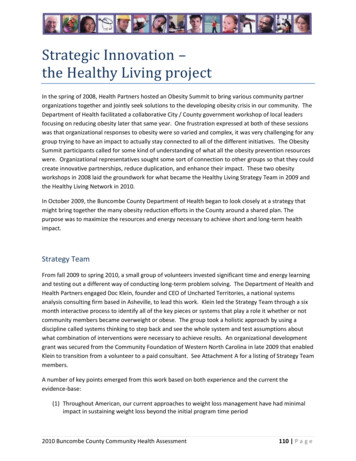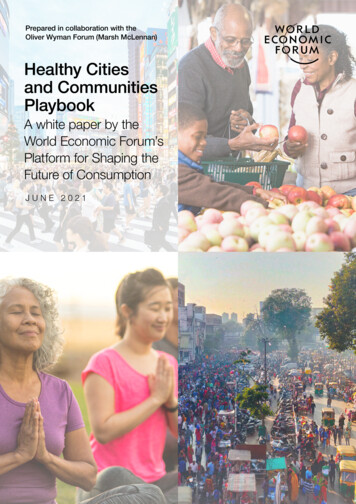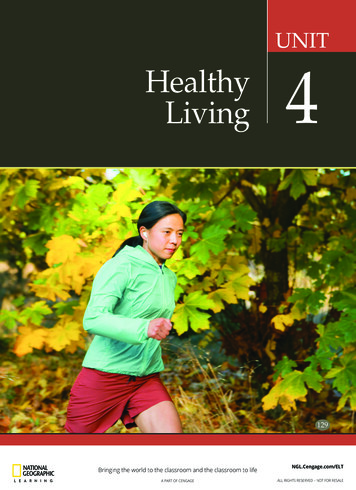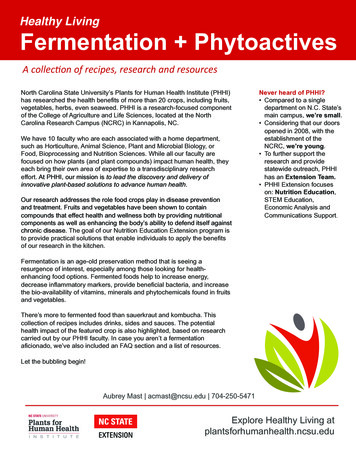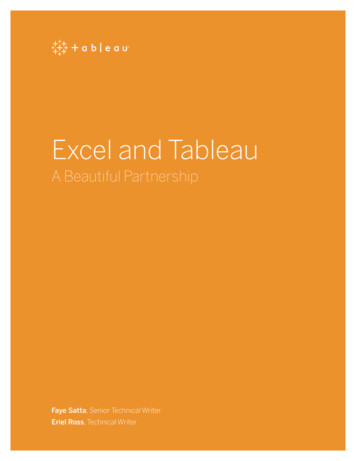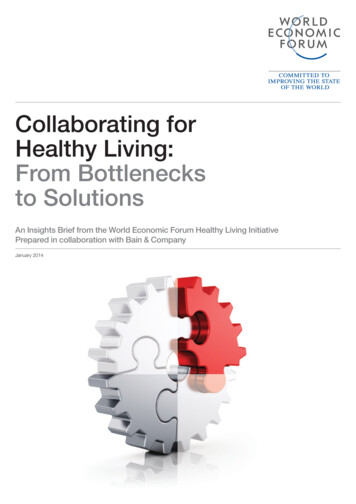
Transcription
Collaborating forHealthy Living:From Bottlenecksto SolutionsAn Insights Brief from the World Economic Forum Healthy Living InitiativePrepared in collaboration with Bain & CompanyJanuary 2014
World Economic Forum2014 - All rights reserved.No part of this publication may be reproduced ortransmitted in any form or by any means, includingphotocopying and recording, or by any informationstorage and retrieval system.The views expressed are those of certain participants inthe discussion and do not necessarily reflect the viewsof all participants or of the World Economic Forum.REF 271213
Contents5Executive summary6Can we tackle the NCD challengeusing traditional policy models?8What are the main bottlenecksfor public, private and civil societycollaboration?11 From bottlenecks to solutions:how can we lay the groundworkfor successful multistakeholdercollaborations?12 The Imperatives: creating a fivestar multistakeholder collaboration17 The Critical Enablers: building aculture of collaboration18 Conclusion and outlook19 ReferencesCollaborating for Healthy Living: From Bottlenecks to Solutions3
4Collaborating for Healthy Living: From Bottlenecks to Solutions
Executive summaryAddressing the rising prevalence of non-communicablediseases (NCDs) and their risk factors challenges traditionalmodels of work for public, private and civil societystakeholders and puts more pressure on them all to workcollaboratively.Furthermore, the five Critical Enablers for building a globalenvironment that facilitates and promotes multistakeholdercollaborations must also be pursued. This requiresdeveloping a partnering mind-set, which can be achievedby:However, such collaborations are not without challenges.Under the umbrella of the Healthy Living Initiative, theWorld Economic Forum has conducted an exercise tomap the most common bottlenecks for multistakeholdercollaborations. This has included a series of 40 in-depthinterviews with public sector, private sector, civil society andacademic experts, input from over 120 participants fromfour multistakeholder dialogues held in Cape Town, NewDelhi, Washington and New York, an extensive literaturereview and the practical lessons learned from the HealthyLiving in India Initiative catalysed by the World EconomicForum in 2013. The most frequently mentioned bottlenecksincluded: mistrust, fear of conflict of interest, lack oftransparency, lack of leadership and fundamentalorganizational differences.–– Sharing data and disseminating information, toolsand evidence–– Increasing capacity for implementers to partneracross public sector, private sector and civil society–– Acknowledging the differences across stakeholdersand building a common language for collaborations–– Increasing opportunities for solution-orienteddialogue with stakeholders from sectors beyondhealthcare–– Developing and disseminating guidance on how tobuild trust and manage interestsThe objective of this brief is not to simply highlight thesekey bottlenecks, but to provide workable solutions forovercoming them. This will be done by providing practicalguidelines for making multistakeholder collaborationssuccessful on the ground (using a “five star” frameworkfor multistakeholder collaboration) and creating a globalenvironment conducive to collaboration (the five “CriticalEnablers”). The five star framework included in thisdocument highlights the need for:1. Building trust and transparency: outcomes to workproactively towards2. Clear objectives, monitoring and evaluation:identifying group goals and mechanisms to achieve them3. Effective governance: the backbone of effective,sustainable and flourishing collaborations4. Secured resources: financial, human and technicalresources to drive and deliver multistakeholdercollaboration5. Strong leadership: invested in the success of acollaborationTackling NCDs is a journey that the global community musttravel together. The global community needs to continuouslybridge different organizational cultures and “languages”in order to find the space where collaboration will bringdifferent benefits to the stakeholders involved as well asto the target populations. When such opportunities areidentified, it is critical to ensure that the public sector, privatesector and civil society work together effectively to make animpact.This brief, in combination with the guidance and templatesof the Multistakeholder Collaboration for Healthy Living –Toolkit for Joint Action (World Economic Forum, 2013), canhelp prepare for the journey ahead and act as a “healthcheck” for on-going collaborations.Collaborating for Healthy Living: From Bottlenecks to Solutions5
Can we tackle the NCDchallenge using traditionalpolicy models?Non-communicable diseases (NCDs) are increasingly takingcentre stage on the global agenda (see Figures 1 and 2). Inorder to tackle the complex and multi-causal origins of theNCD epidemic, there are mounting calls for a system-levelapproach in which stakeholders collaborate across sectors.Yet it is becoming increasingly clear that multistakeholdercollaboration is tremendously challenging particularlybetween business and non-business sectors.The objective of this brief is to lay the groundwork forsuccessful collaborations. This brief begins by mappingout key bottlenecks in multistakeholder collaborationbetween business and non-business sectors. It thenprovides clear and concise recommendations for makingmultistakeholder collaboration work. This is dealt withon two levels: through the five star framework needed tomake collaboration work on the ground and through theCritical Enablers required to build a global environment thatfacilitates and promotes multistakeholder collaborations.Tackling NCDs is a journey that the global communitymust travel together. This brief can help prepare for thejourney ahead and act as a “health check” for ongoingcollaborations.NCDs are already the number one cause of prematuremortality and disability worldwide, with 36 milliondeaths per year. The prevalence of diabetes is oneexample. Already, 45% of US adults (105 million) are eitherdiabetic or pre-diabetic (US Centre for Disease Controland Prevention, 2011). Diabetes prevalence is around 100million in China and 60 million in India (International DiabetesFederation, 2012). Globally, deaths caused by NCDs areforecast to grow by 15% between 2010-2020 (World HealthOrganization, 2008) and will cost the global economy acumulative US 47 trillion in economic output lost by 2030(World Economic Forum and Harvard School of PublicHealth, 2011). These numbers, along with the crushingsocial damage and economic strain they cause, are nolonger possible to ignore.Figure 1: Obesity is a major driver of the NCD epidemicNote: Obesity defined as BMI 30kg/m² (WHO definition); Asian countries with lower threshold; e.g. Japan BMI 25kg/m²Source: WHO (2011: 2008 data)Prevalence of obesity (%) 1010-19.920-29.9 30Data not availableNot applicable6Already multiple countries withobesity prevalence above 30%Collaborating for Healthy Living: From Bottlenecks to Solutions
Figure 2: The NCD epidemic will cost the global economy US 47 trillion over the next two decades – up to 5% of globalGDP in 2030Note: Includes direct personal care costs as well as lost productivity due to mortality and disabilitySource: The Global Economic Burden of Non-communicable Diseases (World Economic Forum and Harvard, 2011)Economic burden of NCDs by country income group(2011-2030, US T) 50T 16T 47TLow income countriesLow-middle countries40 8T30Upper-middle countries 5T20 16THigh income countries10 diseasesCancerThe roots of NCDs are multi-layered and complex,connecting four key influencers: (1) the social determinantsof health (e.g. poverty, unemployment, lack of education);(2) changing global megatrends (e.g. increased economicinstability, ageing, increased urbanization); (3) thegrowing prevalence of risk factors (e.g. physical inactivity,unhealthy diets, harmful use of alcohol, increased tobaccoconsumption); and (4) insufficient access to screening, earlydiagnosis and overall healthcare.Mental Illness2030Such complexity challenges traditional models of workfor public, private and civil society stakeholders and putspressure on all of them to work collaboratively. It requirescomplementary responses: a short-term response totreat acute sicknesses such as strokes, and a long-termapproach to change the environment, culture, value ofhealth and the behaviours of individuals, families andcommunities. This cannot be achieved by working solelywithin the traditional boundaries of healthcare systems. Ithighlights the urgent need to involve stakeholders acrossa variety of sectors, including health, education, foodproduction and distribution, urban planning, developmentand poverty alleviation.Collaborating for Healthy Living: From Bottlenecks to Solutions7
What are the main bottlenecksfor public, private and civilsociety collaboration?There have been examples of successful partnershipsin the global health arena. Historically, these have focusedon infectious diseases as well as maternal and child healthissues (Buse & Harmer, 2007).Given how complex addressing NCDs is proving to be,policy-makers have also called for a more integrated andcollaborative approach to preventing and managing theseconditions (United Nations, 2011).In an assessment survey conducted by the World HealthOrganization, nearly 86% of member states reported thatsome partnerships or collaborations were in place to tackleNCDs at the country level. According to this survey, thesecollaborations included not only other ministries but alsoother UN agencies, academia and (mainly in upper-middleand high income countries) the private sector (see Figure 3).These collaborations most often targeted tobacco use (83%of countries), diabetes (81%), unhealthy diet (77%), cancer(77%), physical inactivity (75%) and hypertension (72%)(World Health Organization, 2012).It is a positive sign that countries are reporting thesecollaborations among public/government entities, private/commercial entities and civil society, as they can improvepopulation health by combining the different skills andresources of various organizations in innovative ways.However, more needs to be done to ensure thesecollaborations are effective and delivering on the targetedhealth outcomes so that they can reach global impact.Nonetheless, implementing collaborative actions doesnot come without risks and challenges. All stakeholdersneed to consider these challenges before engaging in thecollaborative process. Once the collaboration has beendefined, stakeholders need to work continuously to identifypotential problems to delivering results that make an impact.As part of the Healthy Living Initiative, the Forum hasmapped the most common bottlenecks faced by thepublic sector, private sector and civil society in the processof delivering joint action towards a common goal. Thismapping exercise included:–– More than 40 in-depth interviews with public, private, civilsociety and academic experts across sectors–– Input from over 120 participants from fourmultistakeholder dialogues held in Cape Town, NewDelhi, Washington and New York–– Literature review–– Practical lessons learned from the Healthy Living in IndiaInitiative catalysed by the World Economic Forum overthe course of 2013Figure 3: Proportion of member states collaborating with other stakeholders (World Health Organization, 2012)Collaborations with private sectorCollaborations with UN agenciesCollaborations with academiaCollaborations with other, non-health governmentministriesCollaborations with community-basedorganizations and civil society8Collaborating for Healthy Living: From Bottlenecks to Solutions59%- 70% – upper-middle and high income countries- 37% – low income countries68%72%80%82%
Figure 4: Main bottlenecks in the public, private and civil society collaboration processDifferent working styleslack of leadershiplack of technical capacitymismanagement of expectationsconflicting interestsfear of reputational damagediffering partnering mindsetsmistrustCommonpower imbalancesgovernancelowest common denominatorMisinformation of mediaLeadership and middle management inconsistenciesUnwillingness to share dataabsence of rewarding mechanismsresourcesSource: Quantified analysis from World Economic Forum’s structured interview processInconsistency of metrics and evaluationBusiness onlyPublic sector, civil society and academia onlyFigure 4 summarizes the findings of this process and,following a quantitative analysis of the results of the mappingexercise, highlights the commonalities of the bottleneckslisted by each stakeholder group.The assessment repeatedly mentioned five main bottleneckswhen stakeholders from the public sector, private sector andcivil society collaborate:1. Mistrust – Relationships among public sector, businessesand civil society stakeholders have been marked by eventsthat led to poor trust and reinforced suspicion regardingthe motivations for collaboration. This came across in allinterviews and multistakeholder dialogues. Misinformationcommunicated by the media and journalists was seen bymany interviewees as a potential aggravating factor in thismistrust.4. Poor governance – Respondents frequently identifiedlack of clear governance, transparency and accountabilitymechanisms within existing systems as major bottlenecksfor effective collaboration. Most interviewees stressed thatopaque and unaccountable governance mechanisms leadto increased suspicion across stakeholders, with resourcesmore likely going astray and activities increasingly hijackedfor secondary purposes.5. Lack of leadership and resources for collaborativework – The interviews and dialogues consistently highlightedthe need for strong leadership, commitment to the successof the jointly defined goals and dedicated resources forsuccessful collaboration.2. Conflict of interest – Overall, a conflict of interestmay arise when a party’s judgement is influenced by asecondary set of undisclosed interests (financial, ideologicalor organizational) leading to the benefit of one (or more)collaboration entities to the detriment of the collectivegoal. The majority of interviewees stressed that diverseinterests can and should be transparently managed as partof effective collaborations. The fear of reputational damagefrom entering into collaborative efforts was also frequentlyhighlighted.3. Organizational differences – Each organization hasits own identity, culture, speed of work, language andlegal and internal procedures. Being transparent aboutthese differences and acknowledging them upfront ina constructive manner is critical to build trust, shape acomfortable way of working and move forward with jointlydefined actions.Collaborating for Healthy Living: From Bottlenecks to Solutions9
Table 1: Summary of bottlenecks identified by specific stakeholder groupsBottlenecks in the collaborative processes identified by Bottlenecks in the collaborative processes identified bybusiness stakeholderspublic sector, civil society and academic stakeholders–– Unwillingness of public sector to consider differentsources of data and information–– Resistance from public sector to let private sector besystematically involved in dialogue–– Inconsistency or lack of metrics to evaluate thecollaborations–– Mismanagement of partner expectations–– Different partnering mind-sets across industry sectorsand stakeholders–– Absence of reward mechanisms to encourage positivechanges or pioneering actions by private sector–– Lack of pragmatism in goals proposed by non-businessactorsNotably, and in spite of the specificity of the bottleneckslisted above, the public sector, private sector and civilsociety face similar difficulties when trying to collaborate.1. It is often necessary for one or more partners to bridgedifferent organizational cultures and languages tofind the space where collaboration will bring differentbenefits to the stakeholders involved as well as to thetarget populations.2. There is a need to create platforms and processeswhere data and information from a variety of sourcescan be shared, translated into evidence and utilized fordecision-making by all stakeholders.10Collaborating for Healthy Living: From Bottlenecks to Solutions–– Unwillingness of private sector to share data andinformation–– Lack of regulatory frameworks for collaborating–– Insufficient evidence on effectiveness of partnerships–– Involving too many stakeholders may bring thediscussion level down to the lowest commondenominator–– Power imbalances and unacknowledged powerdynamics within the collaborations–– Inconsistency within private sector between high-levelbusiness leadership and middle management or countrypractices–– Lack of transparency regarding the benefits of eachorganization collaborating3. Each stakeholder uses different indicators and ways tomonitor and evaluate their actions within collaborativeefforts. Pulling these together to have consistentmonitoring and evaluation frameworks will helpovercome some of these bottlenecks and build moreeffective partnerships.The mapping exercise suggested that real progress towardsimproved population health would benefit from transparentdialogues among these stakeholders, particularly on neutralplatforms where such dialogues can take place at global,regional and local levels.
From bottlenecks to solutions:how can we lay the groundworkfor successful multistakeholdercollaborations?Tackling the challenge posed by the growth of NCDs cannotbe solved just through increased financial or technicalsupport. It requires working together in a way that ismutually beneficial. Overcoming the common bottlenecksassumes even greater importance as the need forcollaboration becomes increasingly apparent and as policymakers look for relevant opportunities for collaboration.We must address two distinct levels to create successfulmultistakeholder collaborations for healthy living:The Critical EnablersBuilding a global environment that facilitates and promotesmultistakeholder collaborations calls for a “partnering mindset”:–– Sharing data and disseminating information, tools andevidence–– Increasing capacity for implementers to partner–– Common language for partnerships–– Solution-oriented dialogues across borders–– Guidance on building trust and managing interestsThe Imperatives: A five star frameworkTo ensure a multistakeholder collaboration is effective andhas impact, it should be built around five features:1. Trust and transparency2. Clear objectives, monitoring and evaluation3. Effective governance4. Secured resources5. Strong leadershipFigure 5: Levers for multistakeholder collaborationsDisseminating information,tools and evidenceBuilding trustandtransparencyGuidance on building trustand managing interestsClearobjectives,monitoring andevaluationCritical EnablersSolution-orienteddialogues across bordersSecuredresourcesIncreased capacity forimplementers to dershipCommon language forpartnershipsCollaborating for Healthy Living: From Bottlenecks to Solutions11
The Imperatives: creating a five starmultistakeholder collaborationBuilding trust and transparency – outcomes to workproactively towardsBuilding trust is a journey that must be travelled duringthe multistakeholder collaboration. Trust is not necessarilya prerequisite to embarking on a multistakeholdercollaboration. It must, however, be an explicit goal for anysuccessful collaboration.Building trust when collaborating can be systematicallypursued in a number of effective ways:–– Carefully managing the expectations of all partnersinvolved – over-promising and under-delivering canoften destroy trust. Ensuring that all partners are clearregarding objectives, deliverables, roles, responsibilitiesand timelines is essential to avoid these problems–– Consistently delivering on jointly defined deliverablesand outcomes – identifying discrete tasks that can bedelivered in a joint manner is crucial, particularly at thebeginning of the collaboration. These joint deliverablescan increase in scope and complexity as partnersbecome more comfortable working together–– Investing in developing and maintaining personalaffinity – scheduling time for detailed introductions andinformal breaks is essential to allow participants to bondon a personal level. These bonds often translate into abetter understanding of one another’s positions, whichcreates a level of personal affinity that can often helpovercome institutional frictionsThese mechanisms to build trust must begin withtransparency among stakeholders in the collaboration.Outward-oriented transparency also needs to be pursued inorder for the collaboration to be successful.Figure 6: Benefit sharing (World Economic Forum, 2013)Increasing transparency in procedures (particularlyconcerning financial aspects), the decision-making processand most importantly in the interests and expectations arecritical elements to address through the entire collaboration.Communication is an essential tool for increasedtransparency.One of the most frequently cited roadblocks tomultistakeholder collaboration is conflict of interests –both actual and perceived. A first step in overcoming thefear of actual and perceived conflicts of interest includesacknowledging that different organizations will take partin multistakeholder collaboration because they have aninherent interest in doing so. These interests can rangefrom the altruistic to the transactional. For successfulcollaboration, it is important to establish a culture oftransparency where clear processes help to identify andsystematically manage all interests in a partnership.Overcoming conflicts of interest requires open, consistentand continuous communication. To avoid suspicion it isrecommended that every single partner state upfront whattheir interests are in participating in the collaboration andshare with all participants what they believe they will gainfrom the collaboration. Throughout the process, this open,consistent and continuous dialogue must be maintained ascollaborations are dynamic processes in which conflictinginterests may well arise throughout the lifespan of theproject. If necessary, the stakeholders involved maychoose to engage a partnership broker – an individual whocoordinates and facilitates dialogue and understandingacross sectors (Ruuska & Teigland, 2008; Bauer, Boles, &Stibbe, 2010).A strong governance framework and a good understandingof each organization’s culture and way of workingare essential for this process. This framework shouldalso promote regular and open communication wherestakeholders can share their concerns, their changing needsand information about expected benefits (Taut, 2008; GlobalKnowledge Partnership, 2003).Collaboration:Latest update:BenefitSectorStakeholderProprietarydata or fitsStakeholder 1PublicStakeholder 2Stakeholder 3Stakeholder 4Stakeholder 5PrivateStakeholder 6Stakeholder 7Stakeholder 8Civil society& academiaStakeholder 9Stakeholder 1012Collaborating for Healthy Living: From Bottlenecks to Solutionse.g. patient data,insights onHealthy Livingbehaviourse.g. access topartners that canbe leveraged forother activitiese.g. increasedsales, newbusinessopportunities, lessabsenteeisme.g. increasedbrand awarenessfrom HealthyLiving campaign
Figure 7: Managing potential sources of conflict (World Economic Forum, 2013)Source: Adapted from Berger, Ida E., “Social Alliances: Company/ Nonprofit Collaboration”Collaboration:Topic ofconflictLatest update:Questions to identify potential conflicts- Are the objectives of all stakeholders well understood,especially across public/private sector and civil society?Misunderstandings - Is there a mechanism to address culture and languagedifferences in Healthy Living collaboration?MistrustMismatches ofpowerPotential approach- Schedule sufficient time to allowstakeholders to articulate their perspective,especially at the start of a Healthy Livingcollaboration- Do partners openly communicate their interests andgoals in the collaboration?- Is there a shared set of values specific to Healthy Livingcollaborations?- Regularly ask each stakeholder to openlycommunicate their interests and goals- Establish shared values- Openly discuss red flags across sectors- Are operational responsibilities and decision -makingpower distributed in a way that is aligned with allstakeholders?- Are all sectors fairly represented?- Provide clarity on governance structure anddecision rights, and align with allstakeholders- Does every partner benefit in a win -win scenario in this- Transparently review cost and benefit splitwith all stakeholdersMisallocation ofpartnership?costs and- Are costs and benefits distributed fairly among allbenefitsStatusstakeholders?Mismatchedpartners- Do stakeholders have matching goals and visions forHealthy Living action?- Do stakeholders have complementary skill sets,strengths and needs?- Review each stakeholder’s vision and goalsvs. the collaboration objectives- Conduct a skill gap analysis- Are all stakeholders committed to the collaboration in the- Ensure that collaboration is well equippedon the capabilities/assets that matter most- Maintain right culture and operating modelMisalignment oflong term?time horizons - Are there plans in place to keep up the momentum?Clear objectives, monitoring and evaluation –identifying group goals and mechanisms to achievethem–– Acceptable to each and every participant – eachparticipant must not only want to achieve the goal forits own end, but also to be willing to work with all otherparticipants in achieving this objectiveA common unambiguous vision about what success willlook like for the collaboration should build on a crediblemechanism for monitoring and evaluation.Once the channels of communication and interests areestablished, the collaboration must rally all stakeholdersaround the vision and objectives. The objectives of amultistakeholder collaboration must gather maximumcommitment from all participants and should be:–– Inspirational – participating in a multistakeholdercollaboration can be a complicated and energyconsuming activity. The objective of a multistakeholdercollaboration must reflect the different benefits that amultistakeholder collaboration can have, as well asbeing framed in terms of the systemic issues that are thereason for the collaboration–– Clear, achievable and demonstrable – the objectivesof the collaboration must be unambiguous. This reducesthe chance of misunderstanding, which can causefriction. They must also be achievable and demonstrableso that those collaborating can verify that they haveachieved a stated goalCollaborating for Healthy Living: From Bottlenecks to Solutions13
Figure 8: Success statement (World Economic Forum, 2013)Collaboration:What will success look like?Success statement should includequantitative and qualitative targetsHealthy Living impactRelevant and “ trackable ”outcomes, e.g.- Awareness & knowledge- Behavioural changes- Physical and biochemicalchanges- NCD prevalence &mortalityEconomic and social benefitsComment on:Comment on:- Impact on healthcarecosts- Teaming- Productivity increases- Effective collaboration/health checks- Quality of careOnce these objectives are established, the mechanisms tomonitor and evaluate progress and results are essential.This is often the first great challenge of a collaboration anda significant proportion of time should be allocated to itssuccessful completion. Whilst monitoring and evaluation willdiffer by type of collaboration, there are three principles thatare essential:–– Evidence-based – the monitoring and evaluationframework must be based on existing internationalliterature–– Transparent and formal process – the designprocess should be transparent and open to input fromall participants while retaining a formal governanceprocess for resolving potential conflicts and finalizing themethodological design–– Credibility of framework – the final results should betested and validated from both a scientific and interestbased point of view. If necessary, an independent actorcan be involved throughout the process or brought in toreview the agreed-upon designEffective governance – the backbone of effective,sustainable and flourishing collaborationsAt the core of any successful multistakeholder collaborationis an effective and comprehensive governance structure.This should be a priority to complete at the very beginningof a partnership. The governance structure must be definedthrough the involvement and agreement of all partiesand should ensure a fair representation of the differentstakeholders involved in the collaboration.14Collaborating for Healthy Living: From Bottlenecks to SolutionsCollaboration success- Stakeholder engagementThe governance must set out a series of structural decisionsthat form the shape of the collaboration:–– Clear stakeholder selection criteria and processes forincluding/excluding participants–– The governance bodies within the collaboration and theircompositions–– The rules for election to each of these bodies–– The roles and responsibilities for each participant,including a clear set of decision-making rightsRoll Back Malaria, the Stop TB Partnership and the GAVIAlliance are a few examples of public-private partnershipscreated to tackle specific health topics. Each was createdwith an effective governance structure that lays out a clearframework in which participants can collaborate successfully(Roll Back Malaria, 2012; Stop TB Partnership, 2012; GAVIAlliance Board, 2010; GAVI Alliance, 2012).Key to operationalizing the governance of the collaborationis a careful definition of the critical decisions to be madeduring the project. These must be individually examinedin order to pre-assign the decision-making rights to aparticular governance body. It is also i
of the Multistakeholder Collaboration for Healthy Living – Toolkit for Joint Action (World Economic Forum, 2013), can help prepare for the journey ahead and act as a “health check” for on-going collaborations. Collaborating for Healthy



